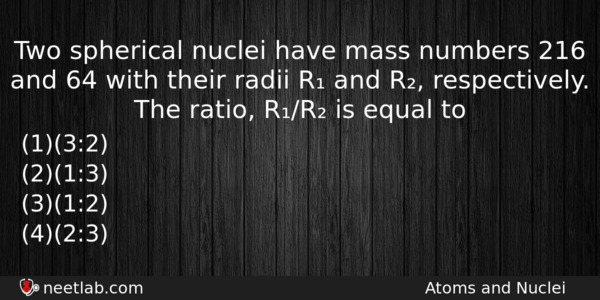| ⇦ | 
| ⇨ |
Two spherical nuclei have mass numbers 216 and 64 with their radii R₁ and R₂, respectively. The ratio, R₁/R₂ is equal to
Options
(a) (3:2)
(b) (1:3)
(c) (1:2)
(d) (2:3)
Correct Answer:
(3:2)
Explanation:
Radius of nuclei having mass number A is determined as
R = R₀ A¹/³ (where R₀ = constant)
where, R₀ = 1.2 x 10⁻¹⁵ m
This implies, R₁/R₂ = (A₁/A₂)¹/³ = (216/64)¹/³ = 6/4
R₁:R₂ = 3:2
Related Questions: - A galvanometer has a coil of resistance 100 ohm and gives a full-scale deflection
- A boy is trying to start a fire by focusing sunlight on a piece of paper using
- In common base circuit of a transistor, current amplification factor is 0.95.
- The condition under which a microwave oven heats up a food item containing
- Application of a forward bias to a P-N junction
Topics: Atoms and Nuclei
(136)
Subject: Physics
(2479)
Important MCQs Based on Medical Entrance Examinations To Improve Your NEET Score
- A galvanometer has a coil of resistance 100 ohm and gives a full-scale deflection
- A boy is trying to start a fire by focusing sunlight on a piece of paper using
- In common base circuit of a transistor, current amplification factor is 0.95.
- The condition under which a microwave oven heats up a food item containing
- Application of a forward bias to a P-N junction
Topics: Atoms and Nuclei (136)
Subject: Physics (2479)
Important MCQs Based on Medical Entrance Examinations To Improve Your NEET Score
18000+ students are using NEETLab to improve their score. What about you?
Solve Previous Year MCQs, Mock Tests, Topicwise Practice Tests, Identify Weak Topics, Formula Flash cards and much more is available in NEETLab Android App to improve your NEET score.
Share this page with your friends

R=R°A^1/3. (R°=constant
R1÷R2 =(A1÷A2)^1/3
=(216÷64)^1/3
=6÷4.
=> R1:R2 = 3:2